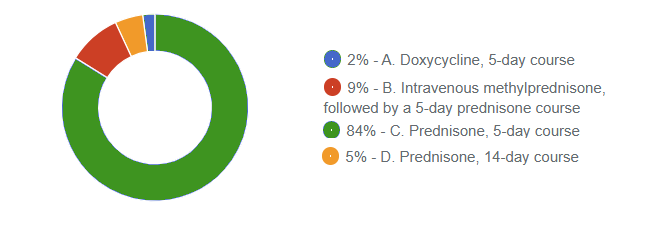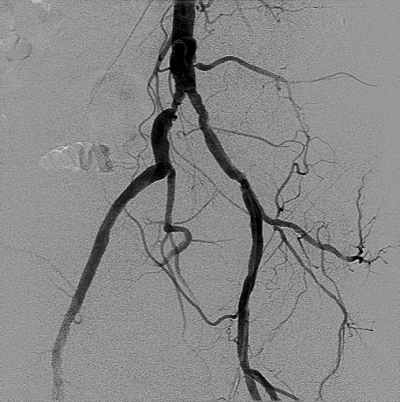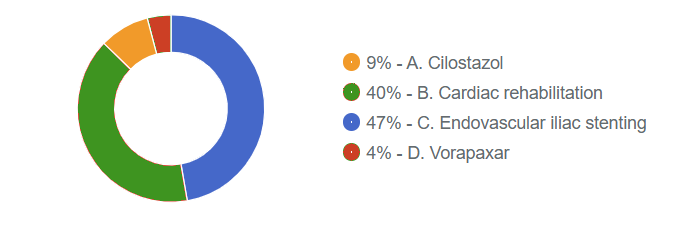NYACP Board Review Question of the Week
Every other Tuesday, NYACP members are sent a Board Review Question from ACP's MKSAP 18 to test professional knowledge and help prepare for the exam. Participant totals and answer percentages are distributed on the first Thursday of the month in IM Connected, the Chapter's eNewsletter, and are also published on this page.
If you are interested in receiving these questions bi-weekly, join us as a member!
If you are a member who needs to receive the questions and newsletter via email, let us know!
January 13th, 2026
MKSAP 19 Pulmonary & Critical Care Medicine, Question 102
A 32-year-old woman is evaluated for an asthma exacerbation. She previously had well-controlled asthma. She has increased the use of her maintenance inhaler and is using her rescue medication four times daily, but her symptoms persist. She reports no fever, chills, chest pain, or purulent sputum. She has no history of intubation, emergency department visits, or hospitalizations for asthma and has adhered to her medication regimen. She is a nonsmoker. His only medication is inhaled budesonide-formoterol.
On physical examination, respiration rate is 25/min; the remainder of vital signs are normal. Oxygen saturation is 96% with the patient breathing ambient air. The patient is not using accessory muscles of respiration and is able to speak in full sentences. There is scattered expiratory wheezing.
Which of the following is the most appropriate treatment?
- Doxycycline, 5-day course
- Intravenous methylprednisone, followed by a 5-day prednisone course
- Prednisone, 5-day course
- Prednisone, 14-day course
Responses Received from Members (670 Responses):

The Correct Answer is: C. Prednisone, 5-day course
Educational Objective: Treat an asthma exacerbation.
The most appropriate management for this patient with an asthma exacerbation is to start a 5-day course of prednisone (Option C). Asthma exacerbation is an acute worsening of symptoms or lung function from baseline that necessitates a step up in therapy. Prompt recognition and treatment of asthma exacerbations are needed to relieve symptoms and prevent hospitalizations. All patients with asthma should have a written asthma management plan that helps them recognize the symptoms of an exacerbation and begin self-treatment. If symptoms do not improve with self-treatment, evaluation is appropriate. Clinicians should screen for patient factors that contribute to an increased risk of death from asthma and should counsel patients appropriately. Important risk factors include a history of near-fatal asthma attack or intubation; an emergency department or hospital visit in the last 12 months; poor asthma medication adherence or not using inhaled glucocorticoid; current or recent treatment with an oral glucocorticoid; psychosocial stressors or psychiatric disease; food allergy; and overuse of a short-acting β2-agonist. On physical examination, signs of a severe asthma exacerbation that should prompt aggressive intervention and hospitalization include being unable to speak in full sentences; use of accessory muscles of respiration; respiration rate greater than 30/min, heart rate greater than 120/min; oxygen saturation less than 90% with the patient breathing ambient air; and agitation, confusion, or drowsiness. This patient does not have any signs of or risk factors for a severe asthma exacerbation; therefore, she can be safely managed as an outpatient. The best next step is to begin an oral glucocorticoid such as prednisone for a period of 5 to 7 days.
Asthma exacerbations do not require antibiotics (Option A) unless other signs suggestive of infection, such as fever, are present.
Patients such as this one with low risk for a severe asthma exacerbation can be treated with a 5- to 7- day course of prednisone. A 14-day course of prednisone (Option D) is unnecessarily long, and intravenous glucocorticoids, such as methylprednisone, followed by a course of prednisone (Option B) is also excessive and unnecessary.
Key Point
- All patients with asthma should have a written asthma management plan that helps them recognize the symptoms of an exacerbation and begin self-treatment.
- Patients with an asthma exacerbation who continue to have symptoms after self-treatment should be treated with an oral glucocorticoid.
Bibliography
Fergeson JE, Patel SS, Lockey RF. Acute asthma, prognosis, and treatment. J Allergy Clin Immunol. 2017;139:438-447. PMID: 27554811 doi:10.1016/j.jaci.2016.06.054
Multiple-choice questions reprinted with permission from the American College of Physicians.
MKSAP 19. © Copyright 2021 American College of Physicians.
All Rights Reserved.
December 30, 2025
MKSAP 18 Cardiovascular Medicine, Question 39
A 64-year-old man is evaluated in the office 7 days after discharge from the hospital for non–ST- elevation myocardial infarction. He was treated with percutaneous coronary intervention using a radial artery approach. Right femoral artery access was initially attempted, but the catheter guidewire could not be passed. During the procedure, an abdominal aortogram was obtained (shown). He has not had any symptoms of claudication. Medical history is significant for hyperlipidemia. He is a current smoker with a 40-pack-year history. Medications are low-dose aspirin, ticagrelor, metoprolol, and atorvastatin.

On physical examination, vital signs are stable. The right femoral pulse is faint, and a bruit is heard over the right femoral artery. No foot or toe ulceration is noted.
In addition to aggressive risk factor modification, which of the following is the most appropriate management?
A. Cilostazol
B. Cardiac rehabilitation
C. Endovascular iliac stenting
D. Vorapaxar
Responses Received from Members (659 Responses):

The Correct Answer is: B. Cardiac rehabilitation
Educational Objective:
Treat asymptomatic lower extremity peripheral artery disease.
In this patient with asymptomatic peripheral artery disease (PAD) and acute coronary syndrome treated with percutaneous coronary intervention, the most appropriate next step in management is cardiac rehabilitation. Cardiac rehabilitation is indicated in all patients after hospitalization for acute coronary syndrome and percutaneous coronary intervention. In some patients, exercise can provoke symptoms of intermittent claudication; however, the presence of PAD is not a contraindication to cardiac rehabilitation.
Cilostazol, a phosphodiesterase inhibitor with antiplatelet and vasodilatory properties, is not indicated in patients without claudication, such as this one. There is no evidence that cilostazol prevents progression of disease or improves outcomes in asymptomatic patients with PAD.
This patient's iliac artery stenosis could be treated safely and effectively with an endovascular approach; however, endovascular treatment of PAD is not recommended in asymptomatic patients. There is no empiric evidence that endovascular intervention prevents disease progression to intermittent claudication or critical limb ischemia.
Vorapaxar inhibits thrombin-induced and thrombin receptor agonist peptide–induced platelet aggregation. Vorapaxar reversibly inhibits protease-activated receptor-1, although its long half-life makes it effectively irreversible. It does not appear to affect coagulation parameters, nor does it inhibit platelet aggregation due to adenosine diphosphate, collagen, or thromboxane mimetic activities.
Vorapaxar has been shown to reduce hospitalizations for acute limb ischemia in patients with symptomatic PAD, an effect that was mostly driven by patients who experienced lower extremity bypass graft thrombosis. When added to standard antiplatelet therapy, vorapaxar was also associated with a significant increase in major bleeding. In this patient with asymptomatic PAD, the benefits of adding vorapaxar to standard therapy are uncertain.
Key Point
Asymptomatic lower extremity peripheral artery disease is managed with aggressive risk factor modification; cilostazol and surgical intervention do not affect progression of disease or prevent acute limb ischemia.
Bibliography
Foley TR, Waldo SW, Armstrong EJ. Medical therapy in peripheral artery disease and critical limb ischemia. Curr Treat Options Cardiovasc Med. 2016;18:42. PMID: 27181397 doi:10.1007/s11936-016- 0464-8
Copyright 2018, American College of Physicians.
